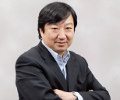Prof. Masatoshi Koshiba passed away on 12 November 2020 at the age of 94. He was one of the giant stars in the field of experimental particle physics.
Born in the city of Toyohashi, Japan, in 1926, he graduated from the University of Tokyo in 1951 and received his PhDfrom the University of Rochester in 1955. After holding a research position at the University of Chicago, he returned to Japan to take a faculty position in the Institute for Nuclear Studies at the University of Tokyo in 1958. When he was named to be the principal investigator of a US balloon-borne cosmic-ray experiment using emulsions, he went back to Chicago again. He finally returned to Japan to be an associate professor of the Physics Department at the University of Tokyo in 1962. It was then that he started to study cosmic muon bundles in the underground mine in the town of Kamioka. This was his first contact to the Kamioka mine.
In the early 1970s, he realised the importance of high-energy electron-positron collider experiments. He started a collaboration with one of the pioneers of e+e– colliders, Gersh Itskovich Budker, director of the Nuclear Physics Institute in Novosibirsk. Unfortunately, soon after they started the collaboration, Budker was struck down by a stroke. In search of new collaborators, Koshiba travelled around Europe and reached DESY, where his old friend from Chicago times Erich Lohrmann was director of research. Koshiba and his group from the University of Tokyo joined the DASP Collaboration at the DORIS e+e– collider at DESY. Soon after they started the experiment at centre-of-mass energy of around 5 GeV, the J/ψ resonance was discovered at the lower centre-of-mass energy of around 3 GeV at Brookhaven National Laboratory and SLAC National Accelerator Laboratory in the U.S. in 1974. Since the importance of e+e– colliders became more evident, DESY decided to construct a higher-energy collider, PETRA. Koshiba, Joachim Heintze (Heidelberg University), Paul Murphy (University of Manchester) and others established the JADE Collaboration at PETRA, JADE standing for the participating countries: JApan, Deutschland, England. To take part in international collaborations in the leading particle physics experiments outside of Japan, Koshiba founded a research institute at the University of Tokyo, which later became the International Center for Elementary Particle Physics, whose researchers today work on ATLAS, MEG-II and ILC. The PETRA experiments discovered the gluon in 1979. In the 1980s, Koshiba’s group moved to CERN to join the OPAL Collaboration at the LEP e+e– collider. Many of his collaborators at JADE also moved to OPAL.
Motivated by the Grand Unified Theory, Koshiba also started to construct a nucleon decay experiment at the Kamioka Mine in the early 1980s by developing a 20-inch phototube with Hamamatsu Photonics.
Although his Kamioka Nucleon Decay Experiment (KamiokaNDE) could not discover nucleon decays, neutrinos from the supernova SN1987A were observed. The observation occurred one month before his retirement from the University of Tokyo, as if the timing had been tuned when the SN1987A had exploded 160,000 years ago. He received the Nobel Prize in physics in 2002 for this observation. He also devoted himself to the construction of the Super-KamiokaNDE experiment with Yoji Totsuka to observe nucleon decays as well as atmospheric neutrino oscillations, a hint of which was almost seen in the KamiokaNDE experiment.
Simultaneously, Koshiba dedicated his efforts to promote the construction of an e+e- linear collider. When the Federation of Diet Members for the ILC was established in 2006, he was invited to give the keynote lecture. In 2008, the Late Honourable Kaoru Yosano, founding member and chair of the Federation of Diet Members for the ILC, and Koshiba helped to establish the Advanced Accelerator Association Promoting Science and Technology in Japan, which is an industry-academia collaboration to promote the realisation of the ILC project.
Using the funds received from the Nobel Prize, Koshiba founded the Heisei Foundation for Basic Science to promote fundamental science for young people. As the chair of the foundation he made contributions to enlightenment activities for fundamental science.
Many of his students became leaders in the field of high-energy physics in Japan. The list includes Shuji Orito, Sakue Yamada, Yoji Totsuka, Hiroshi Takeda, Tomio Kobayashi, Takaaki Kajita and others. Koshiba always told us that researchers should brood several eggs of unique ideas and check time to time current technologies or theoretical situation if some of them can be hatched out or not.
He was also known to be a tough teacher for the first-generation students. When we were his students, however, he was already a good-natured old man. But his first generation students became much tougher teachers, so that Prof. Koshiba did not have to be too strict…
We owe a lot to Koshiba-sensei for his leadership, which was based on many ideas in the field of experimental particle physics, including collider physics and astroparticle physics, as well as for his efforts on international collaborations.


Recent Comments